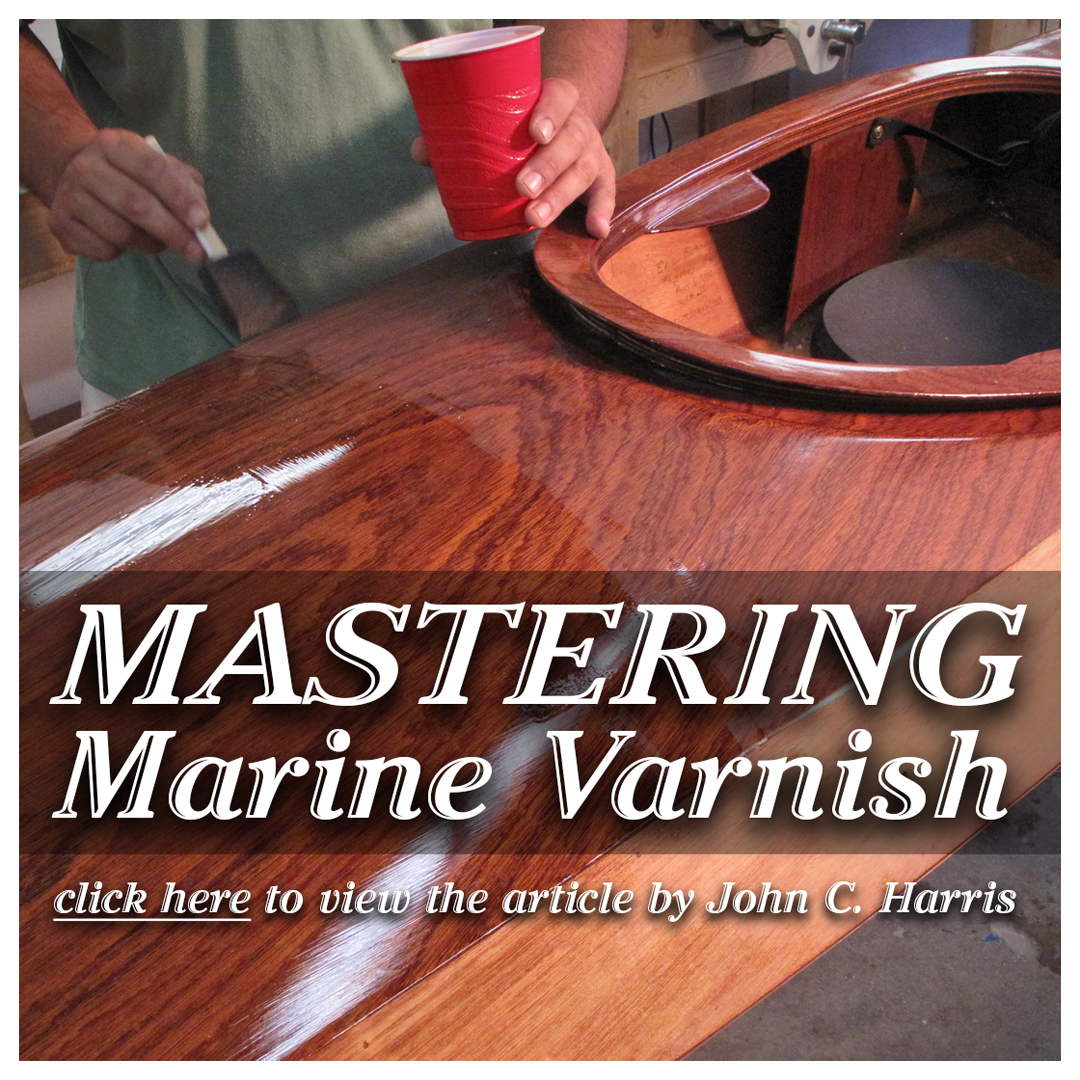Builders' Forum |
|
| ↓ Scroll to Last Comment ↓ | Forum Guidelines | Builders' Forum | |
In the final stages of a Northeaster Dory build and I'm seeing some weird, milky yellow spots here and there in the corners of the inside hull from the latest coat of varnish. It scratches off with a finger nail. The rest of the varnish looks great, but I can't figure out what is causing the weird areas. It looks like it has pooled and then maybe had a bit of humidity hit or something? I'm wiping thinned varnish to keep the coats thin, which worked beautifully on the twarts, spars, and rudder. Any ideas on why I'm getting this weird milky stuff? Thanks.
13 replies:
RE: Milky yellow varnish spots...
Apparently I'm not cool enough to be allowed to look at the pictures. The server tells me that Android-based web browsers are not supported.
Laszlo
RE: Milky yellow varnish spots...
Sorry @Laszlo. Try this: https://photos.app.goo.gl/wtY65V71AHZzEhd8A
RE: Milky yellow varnish spots...
thanks for sharing the pictures.
i have over 15 boats with significant bright work on them and have seen a lot, but nothing exactly like this. the good news is, overall, the bright work looks great so the problem does not strike me a systemic...but something very localized....so what's happening in these little spots?
my first though is if, as you said, you can scratch these little imperfections off and lightly recoat them (without allowing the varnish to pool) and they are fine, then your problem was probably some kind of surface contamination that collected into these crevasses. my initial thought was potentially sanding dust that did not get wiped away (due to being in a little crack) or potential surface prep pooling in this crevass and then you are overcoating onto that (are you wiping down the surface prior to varnish with water or lacquer thinner?) before the surface prep has evaporated.
a quick internet search points to water mositure contamination as a comon cause of 'milkiness'....which could be collecting in these little crevasses (due to dust, or failure to dry a previously wet surface). so making sure everthing is nice and dry and working on low humidity days is something that i have always paid attention to. little places where the varnish pools are more suseptable to this kind of contamination and even absent contamination, will not harden properly becuase the varnish won't cure properly if it is a little pool.
h
h
RE: Milky yellow varnish spots...
Thanks a ton for the response. I can scratch them off but I haven't tried lightly recoating them. I'll give that a shot. I had wiped down the boat with denatured alcohol prior. I assume that's a suitable solvent for wipe down? It was a humid day and I'm starting to think that my garage might be overly humid as well. I do have tiny pockets in the hull gaps and I'm wondering if they are even addressable. Maybe a tougher solvent to get the crust yellow out? I'll try some new varnish and will report back. Thanks again for sharing the wisdom.
RE: Milky yellow varnish spots...
Depending on the alcohol it actually will have some water in it. So when it makes a little puddle and dries by evaporation it might leave a little moisture behind. I'd try to warm the area up to get slightly lower relative humidity. Or use a hair dryer to make sure all the corners are dry.
RE: Milky yellow varnish spots...
>> I had wiped down the boat with denatured alcohol prior. I assume that's a suitable solvent for wipe down? <<
That's what CLC recommends.
https://www.clcboats.com/shoptips/finishing-tips/varnished_kayak.html
They say to let it evaporate at least 30 minutes before varnishing.
>> It was a humid day and I'm starting to think that my garage might be overly humid as well. <<
The data sheets for both Interlux Schooner Varnish and Pettit Captain's Varnish advise against varnishing on high humidity days. They don't define what "high humidity" means. Pettit's performance enhancer says avoid 90% humidity or above.
RE: Milky yellow varnish spots...
Thanks all for the responses. I had let it evaporate for more than 30 minutes for sure. I'm using Schooner and the humidity was 60%+ in the garage, which is high for NorCal, but maybe not high enough to create issues. At this point I'm not sure what's causing it, but most of the spots are in areas where flotation and thwarts will hide the mess. I'm starting to think that it's my first boat and should probably just chill out and embrace the imperfection.
RE: Milky yellow varnish spots...
denatured alcohol as a wipe-down on the glass before varnishing is just fine assuming it has a chance to evaporate off. i do it all the time with fine results.
sometimes we have little issues like this that we never truly figure out the root cause....we just fix it or ignore it and move on.
fwiw....at least for me looking at the pictures, i think it looks pretty good and not a mess in any way. that said, being chill is a helpful attribute to work your way through the inevitable unexpected results of any work step.
a good bit of perspective is to take three paces back and take another picture of your boat. you will never see these little spots from a normal vantage point that you and others will really view your boat.
h
RE: Milky yellow varnish spots...
I varnish in a garage in Florida. Humidity is often higher than 60. I wipe off with denatured alcohol and have not gotten similar spots. But what you have really looks minor.
I find it interesting that there is a dot on the row lock pin hole block at both ends in the same place.
RE: Milky yellow varnish spots...
"I find it interesting that there is a dot on the row lock pin hole block at both ends in the same place."
I wondered about those too, but w/o a second pic from a different angle I'm not sure those aren't specular highlights like the smaller one at the rim of said hole.
From the other tiny bits of stuff in the otherwise virtually flawless varnish I'm leaning towards some kind of solids that gelled out in the can, between coats perhaps?
H2OMansLibrary, are you in the habit of decanting the varnish you intend to use thru a fine-mesh filter? Or using something to drive the air out of your cans before closing the lid at the end of a session?
RE: Milky yellow varnish spots...
my question would be are you certain that the spot was not there after sanding/surface prep.
in the past i have had white spots (i am not sure i would describe what you have here as milky) where i did not properly get rid of dust in a crevace....and then varnished on top of it.
i use a toothbrush with denatured alcohold to make sure little divots like this get cleaned out to prevent white (which become yellow under varnish) sanding dust dots.
h
RE: Milky yellow varnish spots...
You guys are great. Thanks so much for the group support.
I am filtering through a fine mesh sieve and keeping the varnish in stop loss bags (which are a freaking revelation). I also reached out to Jamestown and Interlux. The general thesis is contamination from sanding and a less than thorough wipe down with denatured alcohol. Net-net, it looks like some dust got stuck in the little divots here and there, or in the areas where the varnish had a chance to pool, and then it wreaked havoc on the varnish. I tested unthinned varnish on the aft fillets, which aren't visible when the seats are installed, to see if the spots all over those (I didn't share those pics) would go away the way they did after a alcohol wipe down (although after evaporation, they return). Early results seem to indicate that the thicker varnish application with a brush covered up the yellow spots. Of course, it might just take longer for them to show up again given the varnish thickness, but I'll know more tomorrow given it's 85 degrees out here righ now and the varnish is drying quickly. Again, thanks for all the support. Definitely appreciated.













RE: Milky yellow varnish spots...
» Submitted by H2OMansLibrary - Sun, 10/11/20 » 1:23 PM
Here is a link to what it looks like:
https://share.icloud.com/photos/0Kv-wFNfeS_TNt9fBFp3dstMA